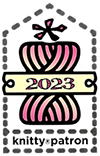Substitution Solutions, a column where a spinner uses her knowledge of fiber, yarn construction and knitting to substitute yarns by Jillian Moreno
INTRODUCTION
Substitution Solutions
How to substitute yarn in a pattern
It’s so important for a knitter to feel comfortable substituting a yarn. More and more designers are offering substitution ideas in their patterns, or at least a description of the type of yarn to look for when choosing a substitute, and you'll find helpful descriptors of Yarn Characteristics in every Knitty pattern starting with Winter 2021.
In this new column, I will walk you through substituting yarn for a couple of patterns in the current issue. My choices are based on how I – as a spinner – look at a yarn and a pattern, making choices based on what I know about fiber, yarn construction, and knitting. Even if the recommended substitution yarns are discontinued one day, my hope is that the information below will make the process of choosing a yarn less daunting, and help you knit projects that give you joy in the knitting and wearing.
Kardiana

Kardiana Sweater by Vladimira Ilkovicova
Kardiana is a striking two-color sweater that utilizes chained embroidery for the heart motif. It’s knit from an aran/chunky wool-blend yarn, at a larger gauge than the ball band calls for.
Yarn Specified in the pattern: Air Wool Multi and Air Wool Drops by Himalaya
- Fiber: 76% acrylic/13% nylon/11% wool
- Type of Spin: worsted and likely brushed
- Ply: chainette
- Length/ Weight: 167 yards/153 meters | 3.53 ounces/100 grams
- Ballband Gauge: 14 stitches x 16 rows to 4 inches/10cm
- Pattern Gauge: 10 stitches x 17 rows to 4 inches/10cm

Himalaya Air Wool Drops
What is important about this sweater? The heart is the big element of this sweater. When choosing a substitute yarn, keep in mind the yarns will need enough contrast for the heart to show, and can’t be so heavy that the embroidered heart sags.
What elements of yarn construction should we think about? This is an Aran yarn knit at a larger gauge than the ball band indicates, and yet the garment still has structure. This indicates that there is loftiness in the yarn somehow, in the spin or the plying.
The yarn used for the sweater is a chain construction (think I-cord) and the fibers look brushed. The openness of a chain construction yarn makes a larger-sized yarn very light. The brushing of yarn to make it fuzzy helps the stitches grab on to each other when knitting at a looser gauge so the garment keeps it shape. The sweater is knit in pieces and seamed which also helps it keep its shape at a more open gauge. Both of these yarn elements help the chain embroidery hold on to the sweater and keep the embroidery from being heavy and making the sweater sag.
Substitution Solution: One yarn I would recommend for this sweater is Woolfolk Luft, which is also a chainette yarn. It is cotton on the outside (the i-cord part), and it has merino fiber blown inside the chain. The cotton helps to give the yarn structure, and the merino fiber is light, lofty and warm.
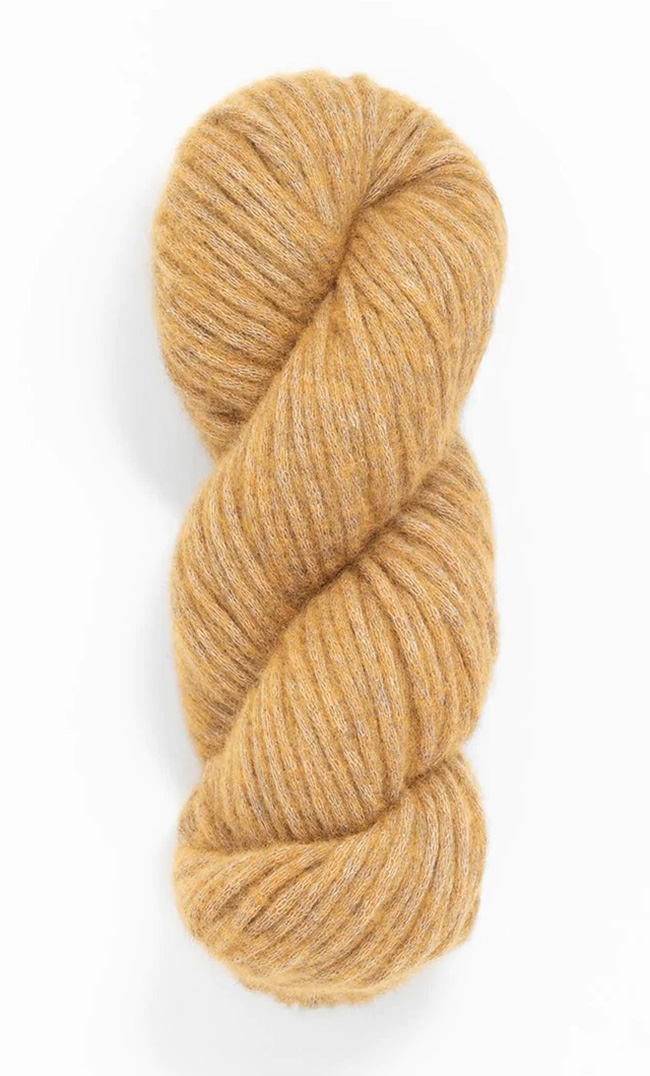
Woolfolk Luft
Another yarn is a classic for knitting at a looser gauge: Lopi. Lopi yarn is spun with a woolen draft which makes a yarn very airy, and fuzzy. The spinning twist is allowed to zip into fiber to make yarn without any smoothing or squeezing the air out. Lopi can be knit much looser than the ball band indicates.
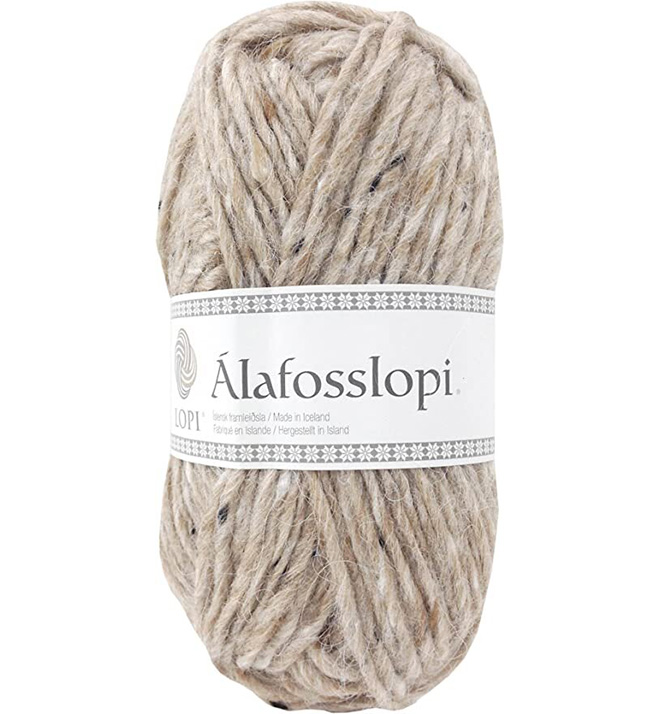
Álafosslopi
Remember, you don’t have to use the same yarn for the sweater and the embroidered heart. You could use a solid, semisolid or gradient yarn for the sweater all in one color and Noro Kureyon for the heart.
Spinning Solution: I would choose a fiber or blend that is lofty and soft, since it will like be worn against your skin, something like Polwarth or Targhee. Woolen drafting is the way to go for this yarn, and 2-plys to keep the yarn tidy and give a bit of protection from pilling.
Woolfolk Luft
Fiber: 55% Ovis 21 Ultimate Merino®/45% Organic Pima Cotton
Ply: chainette with Merino fiber blown inside
Length/ Weight: 109 yards/100 meters | 1.76 ounces/50 grams
Gauge: 11-14 stitches / 18-22 rows to 4 inches/10 cm
Álafosslopi
Fiber: 100% Icelandic Wool
Type of Spin: woolen
Ply: Singles, parallel
Length/ Weight: 109 yards/100 meters | 3.75 ounces/100 grams
Gauge: 13 stitches to 4 inches/10 cm
![]()
Middle School
Middle School is a fantastic intarsia sweater, bringing back all those memories of middle school doodles. It’s knit from a smooth, chunky superwash wool, a little tighter than the ball band gauge.
Yarn Specified in the pattern: Cascade 128 Superwash
- Fiber: 100% Superwash Merino
- Type of Spin: worsted
- Ply: 2-ply
- Length/ Weight: 128 yards/117 meters | 3.53 ounces/100 grams
- Ballband Gauge: 14 stitches to 4 inches/10cm
- Pattern Gauge: 14.5 stitches x 24 rows to 4 inches/10cm
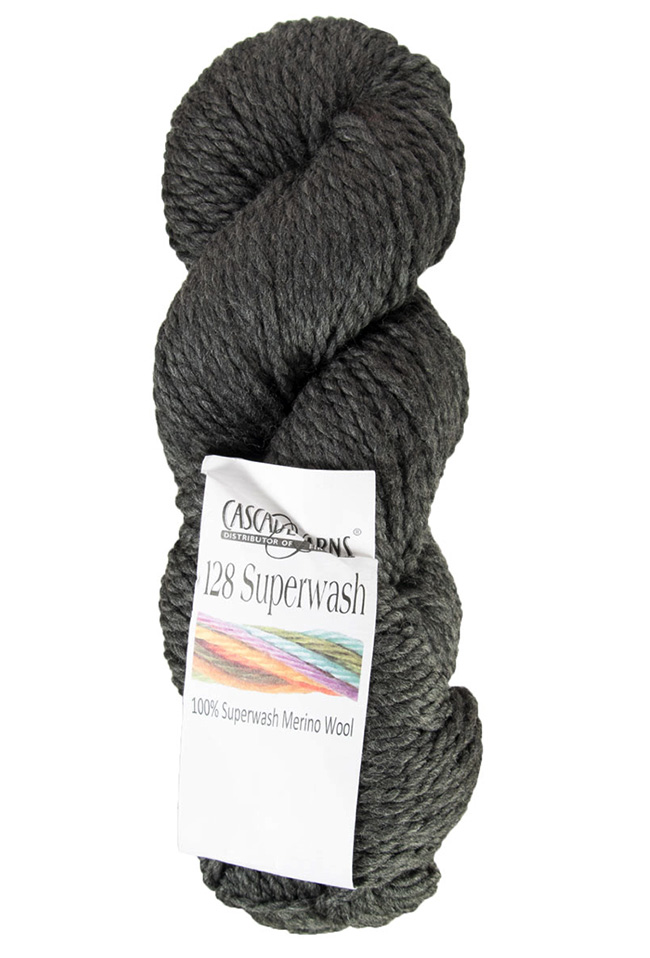
Cascade 128 Superwash
What is important about this sweater? Crisp stitch definition and smooth yarn so we can see all of the intarsia pattern clearly.
What elements of yarn construction should we think about? A great yarn for this sweater is one that has no fuzz, or tweedy bits. A 3-ply (or more) yarn gives the best stitch definition for intarsia, the stitches have clean edges and don’t blend (like in Fair Isle). A 2-ply yarn will work too, just make sure it’s smooth. It doesn’t have to be superwash.
Substitution Solution: A yarn that I would suggest for a sub is Malabrigo Chunky, a soft kettle dyed, 3-ply, Merino yarn. Because it is kettle-dyed it is more of a semi-solid than solid yarn, so make sure to use two colors that have high contrast (like black and white).
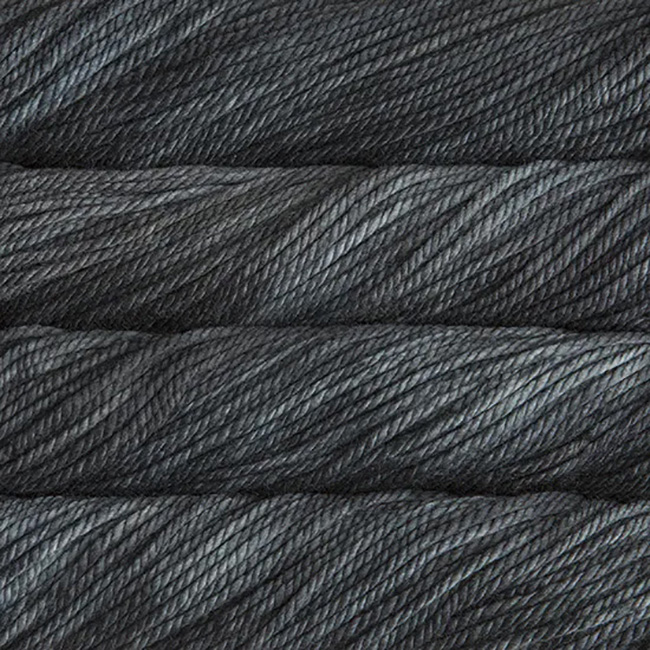
Malabrigo Chunky
Another great yarn for this sweater is Berroco Ultra Alpaca Chunky. It is 50% wool/ 50% alpaca, it’s 2-ply and has a tiny bit of fuzz. If you use Ultra Alpaca Chunky, your stitches will be softer looking, and not quite as crisp, but not so soft that it will distort the intarsia. Ultra Alpaca makes a very warm snuggly sweater.

Berroco Ultra Alpaca Chunky
Spinning Solution: I would spin a 3-ply, worsted drafted yarn. I would choose a fiber or blend that is easy to spin smoothly, wool with maybe a little silk. My personal pick would be Corriedale blend with up to 20% silk. I would also be careful when I finish my yarn, making sure not to finish in a way that encourages blooming or fuzzing, like whacking.
Malabrigo Chunky
Fiber: 100% Merino
Type of Spin: worsted
Ply: 3-ply
Length/ Weight: 104 yards/95 meters | 3.75 ounces/100 grams
Gauge: 14 stitches to 4 inches/10 cm
Ultra Alpaca Chunky
Fiber: 50% Super Fine Alpaca, 50% Peruvian Wool
Type of Spin: worsted
Ply: 2-ply
Length/ Weight: 131 yards/120 meters | 3.75 ounces/100 grams
Gauge: 14 stitches /20 rows to 4 inches/10 cm
![]()
ABOUT THE AUTHOR
 Jillian Moreno is Knitty's Catalyst and Spinning editor. She's the Developmental Editor for PLY Magazine and PLY Books. A couple years ago, she wrote the best-selling spinning bookYarnitecture: A Knitter’s Guide to Spinning: Building Exactly the Yarn You Want. Now she’s writing another spinning book and trying hard not to start weaving.
Jillian Moreno is Knitty's Catalyst and Spinning editor. She's the Developmental Editor for PLY Magazine and PLY Books. A couple years ago, she wrote the best-selling spinning bookYarnitecture: A Knitter’s Guide to Spinning: Building Exactly the Yarn You Want. Now she’s writing another spinning book and trying hard not to start weaving.
She lives in a house packed with fiber and books and has a hand-spinning Patreon over here.
Pattern & images © 2022 Jillian Moreno. Contact Jillian







